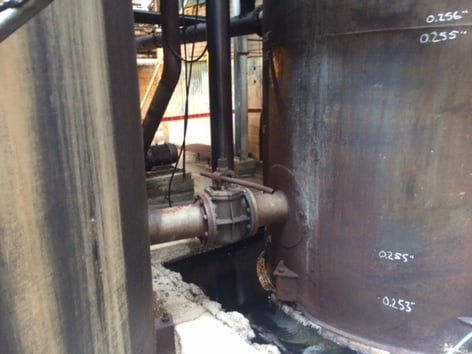The Crucial Duty of Container Welding Examination in Ensuring Structural Honesty and Security Compliance in Industrial Applications
In the realm of industrial applications, container welding evaluation arises as a critical component in safeguarding structural honesty and guaranteeing conformity with safety policies. Making use of a combination of methods such as aesthetic assessments and progressed screening methods, these assessments offer to identify and minimize potential flaws prior to they intensify right into considerable risks.
Significance of Tank Welding Inspection

Making certain conformity with market requirements and guidelines is another considerable facet of tank welding evaluation. Regulatory bodies mandate strict standards for the building and upkeep of storage space tanks, and comprehensive assessments assist organizations follow these demands. Non-compliance can result in serious penalties, consisting of penalties and shutdowns, better highlighting the demand for strenuous assessment methods.
Moreover, container welding evaluation plays an essential function in preserving functional effectiveness. Regular assessments can identify potential concerns prior to they rise, promoting timely repairs and reducing downtime. This proactive technique not just improves safety and security however likewise adds to cost financial savings over time. In recap, the significance of container welding examination hinges on its ability to secure public health and wellness, protect the environment, and ensure compliance with regulative frameworks.
Trick Examination Strategies
Efficient tank welding evaluation depends on a range of essential methods that guarantee detailed examination of weld high quality and architectural integrity. Amongst the most widespread methods are aesthetic evaluation, ultrasonic testing, radiographic testing, and magnetic bit testing - Tank Welding Inspection. Each approach provides distinct advantages in analyzing different aspects of the weld
Visual evaluation works as the first line of defense, permitting examiners to recognize surface area defects, irregularities, or variances in the weld grain. Ultrasonic screening uses high-frequency acoustic waves to spot interior problems, such as splits or voids, supplying a detailed analysis of weld integrity. This approach is particularly efficient in detecting concerns that may not be visible on the surface area.
Radiographic testing makes use of X-rays or gamma rays to produce photos of the welds, disclosing interior gaps and offering an irreversible record for future referral. This strategy is highly efficient for vital applications where the threat of failing must be lessened.
Lastly, magnetic particle testing is employed to recognize surface and near-surface defects in ferromagnetic products. look here By using magnetic areas and great iron bits, assessors can identify suspensions that may endanger the architectural honesty of the container. With each other, these methods create a durable structure for guaranteeing high-quality welds in commercial applications.
Compliance With Security Specifications

Routine examinations play an essential function in making certain compliance by recognizing prospective failings or discrepancies from recommended criteria. Assessors are educated to review weld quality, validate product specs, and assess the total architectural honesty of tanks. Their know-how is essential in making certain that welding procedures meet the called for safety standards.
In addition, compliance with safety standards not only secures employees yet additionally safeguards the environment from prospective hazards such as leaks or catastrophic failings. Organizations that focus on safety conformity are much better placed to reduce threats, enhance operational performance, and promote a culture of security within their labor force. In recap, keeping extensive conformity with safety and security standards is important for the effective operation of container welding tasks in industrial setups.
Advantages of Normal Evaluations
Normal inspections are indispensable to preserving the architectural honesty and safety of welded storage tanks. These examinations offer an organized technique to identifying possible flaws or weak points in the welds, making sure that any concerns are attended to before they intensify right into significant failings. By performing regular assessments, companies can identify deterioration, fatigue, and various other kinds of damage that might compromise container efficiency.
In addition, consistent examinations contribute to compliance with industry laws and requirements. Adhering to these standards not only reduces legal threats however likewise improves the organization's reputation for safety and dependability. Routine inspections promote an aggressive safety and security society, encouraging staff members to acknowledge and focus on the significance of equipment integrity.

Situation Studies and Real-World Applications
Study and real-world applications show the concrete influence of effective tank welding examination techniques. One remarkable instance is a big petrochemical facility that encountered significant functional disruptions due to leakages my sources in tank. Adhering to the execution of extensive welding examination protocols, including aesthetic and ultrasonic screening, the center identified essential flaws in weld joints that might have led to disastrous failings. This positive method not only stopped ecological dangers however also saved the business millions in potential cleanup prices and regulatory fines.
Likewise, a water therapy plant applied a comprehensive inspection program for its container welding operations - Tank Welding Inspection. By including non-destructive screening methods, the plant had the ability to identify very early indicators of rust and exhaustion in weld joints. This prompt treatment extended the lifespan of the containers and ensured compliance with security guidelines, therefore securing public health and wellness
These study emphasize the importance of routine and organized container welding assessments. By focusing on these practices, industries can minimize dangers, enhance structural his response honesty, and guarantee compliance with safety standards, ultimately resulting in enhanced operational performance and lowered obligations.

Verdict
In final thought, storage tank welding examination is an important part of maintaining architectural stability and safety and security in industrial applications. Using various evaluation techniques makes sure early detection of potential flaws, therefore preventing catastrophic failings.